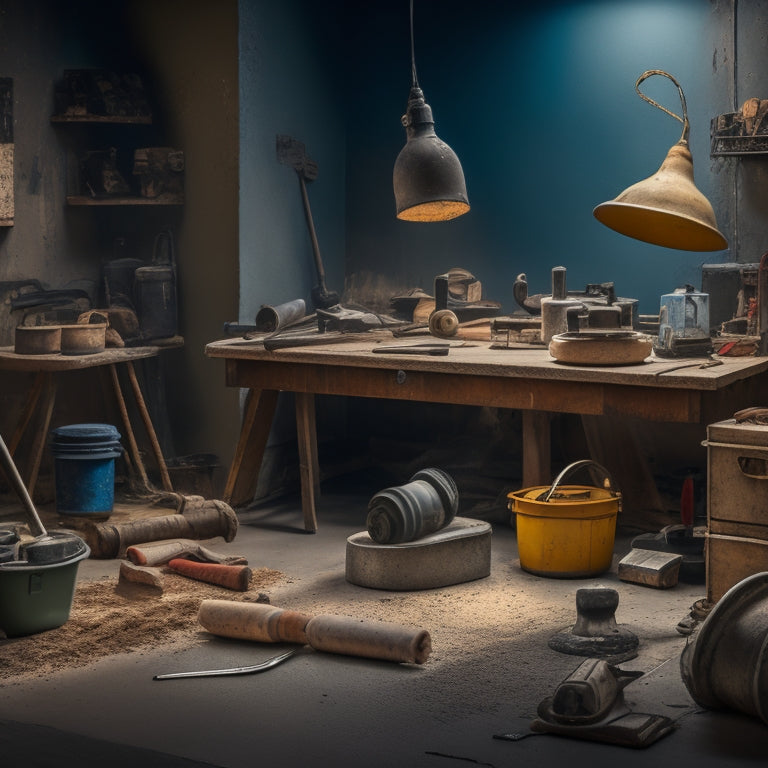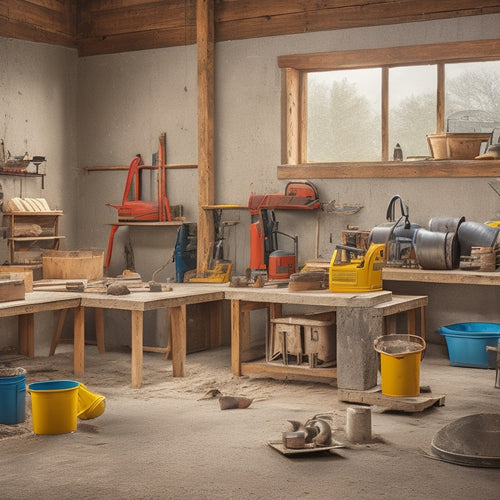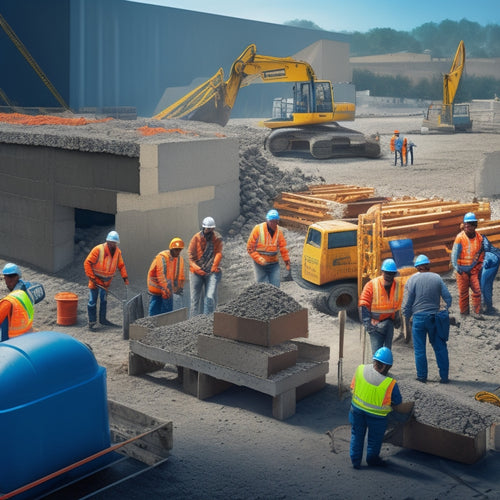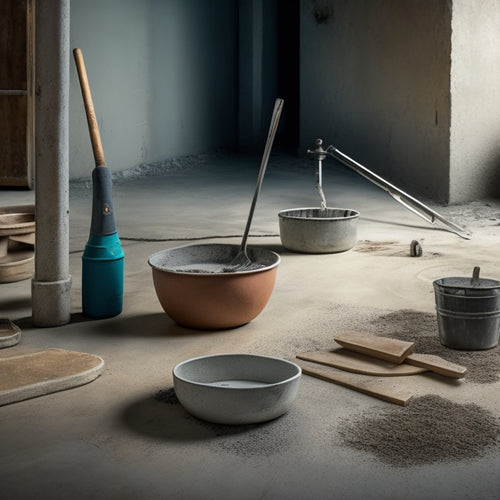
Top Concrete Resurfacing Tools for a Pro Finish
Share
When it comes to achieving a professional finish in concrete resurfacing projects, you require the right set of specialized tools. From essential grinders for smooth finishes to exceptional edgers for clean lines, every tool plays a vital role. You'll need high-quality trowels for even coats, specialized scrapers for removing old coatings, and heavy-duty mixers for consistency. Additionally, precise leveling tools are important for perfection. By selecting the right tools for your project, you'll be able to achieve a pro finish that meets your high standards. Now, take a closer look at each of these tools to discover how they can elevate your concrete resurfacing skills.
Key Takeaways
• Proper grinder selection is crucial for achieving a professional finish, considering factors like concrete type and desired finish level.
• The right sander choice, such as walk-behind or ride-on, depends on floor size, budget, and desired finish, ensuring reduced labor time and superior results.
• Edgers are essential for clean lines and precise edges, with design features like ergonomic handles and rotating heads for customization.
• Trowels, such as v-notched or flat, require regular maintenance and material selection for smooth, even coats of concrete.
• Investing in quality tools like laser levels, digital inclinometers, and optical levels ensures professional-grade results and prevents unevenness in concrete projects.
Essential Grinders for Smooth Finishes
You'll need a reliable grinder to achieve a smooth finish, and a planetary grinder or a high-speed grinder is vital for most concrete resurfacing projects. When choosing a grinder, consider the type of concrete you're working with and the level of finish desired.
Planetary grinders are ideal for removing old coatings, repairing damaged concrete, and achieving a high-gloss finish. High-speed grinders, on the other hand, are better suited for removing thin layers of material and preparing surfaces for coatings.
When operating a grinder, safety features are important. Look for grinders with dust collection systems, which reduce airborne particles and improve visibility. Additionally, consider grinders with variable speed controls, which allow you to adjust the speed to suit the task at hand.
Other necessary safety features include soft-start motors, which reduce startup torque, and ergonomic handles, which reduce fatigue and improve control. By selecting the right grinder type and prioritizing safety features, you'll be well on your way to achieving a smooth, professional finish on your concrete resurfacing project.
Best Sanders for Concrete Floors
When it comes to achieving a high-gloss finish on concrete floors, frequently using the right sander can make all the difference in reducing labor time and producing a superior result.
You'll want to choose a sander that suits your specific needs, and that's where understanding the best features of different sander types comes in.
You'll find three main types of sanders: walk-behind, ride-on, and handheld.
Walk-behind sanders are ideal for large areas, offering high productivity and ease of use.
Ride-on sanders are perfect for massive spaces, providing increased efficiency and reduced operator fatigue.
Handheld sanders, on the other hand, are great for smaller areas, corners, and edges, offering precision and control.
When selecting the best sander for your concrete floor, consider factors such as the floor's size, your budget, and the desired finish.
Look for sanders with adjustable handlebars, dust collection systems, and variable speed controls – these features will make your job easier and more efficient.
Top-Notch Edgers for Clean Lines
Achieving clean lines and precise edges on your concrete floor requires the right edger, as it's this crucial step that sets the stage for a professional-looking finish.
You'll want an edger that can handle decorative edging with ease, creating crisp, clean lines that make your floor stand out. Look for edgers with ergonomic designs that fit comfortably in your hand, reducing fatigue and improving control. A high-quality edger should also have adjustable handles and rotating heads, allowing you to customize the angle and depth of your cuts.
When choosing an edger, consider the type of concrete you're working with and the level of precision you need. For instance, if you're working with intricate designs or tight spaces, a smaller, more agile edger may be your best bet. On the other hand, larger edgers are better suited for larger areas and more heavy-duty projects.
Whatever your needs, investing in a premium edger will pay off in the long run, giving you the clean lines and professional finish you're aiming for. By selecting the right edger for your project, you'll be well on your way to achieving a stunning, showroom-quality finish.
High-Quality Trowels for Even Coats
With clean lines and precise edges in place, it's time to focus on applying even coats of concrete with a high-quality trowel that can handle the demands of your project.
You'll want to choose a trowel that suits your specific needs, as there are various types designed for different applications. For instance, a V-notched trowel is ideal for applying thin coats, while a flat trowel is better suited for thicker applications.
Proper trowel maintenance is essential to guarantee a smooth, even finish. Regularly clean your trowel with a wire brush to remove any dried concrete, and apply a rust-inhibiting coating to prevent corrosion. It's also important to store your trowel in a dry place, away from direct sunlight.
When selecting a trowel, look for durable materials, such as stainless steel or high-carbon steel, which can withstand the rigors of your project. A comfortable, ergonomic handle is also important, as it will reduce fatigue and improve your overall control.
Specialized Scrapers for Old Coatings
When resurfacing concrete, you'll often encounter old, worn-out coatings that need to be removed.
You'll need to choose the right scraper for the job, depending on the type of coating and its level of adhesion.
Removing Old Paint
Scrape off old paint with a specialized scraper, designed to tackle stubborn coatings that refuse to budge. These tools are specifically engineered for paint stripping, making it easier to remove old paint without damaging the underlying concrete surface.
When selecting a scraper, look for one with a durable blade and comfortable grip, allowing you to work efficiently and effectively.
Before you begin, make certain the surface is clean and free of dirt, oil, or other substances that might interfere with the paint stripping process. A thorough surface cleaning is essential to guarantee a smooth, even finish. Use a pressure washer or a degreaser to clean the surface, and let it dry completely before scraping off the old paint.
With the right scraper and a clean surface, you'll be able to remove old paint quickly and easily, revealing a smooth, even surface ready for resurfacing. Remember to work in small sections, scraping in one direction to avoid scratching the concrete.
Coating Removal Methods
You'll need to employ specialized coating removal methods to tackle stubborn, old coatings that require more than just a standard scraper. When dealing with thick, multi-layered coatings or those with strong adhesion, you'll need to bring in the big guns.
Chemical removers can be effective, but they often come with environmental and health concerns. Fortunately, eco-friendly options are becoming increasingly available. These alternatives, such as soy-based or plant-based removers, can be just as effective without the negative side effects.
For particularly tough coatings, you may need to use a combination of methods. This could include using a specialized scraper designed for specific coating types, followed by a chemical or eco-friendly remover to finish the job.
It's crucial to choose the right tool for the job, as using the wrong method can damage the underlying concrete or leave behind residue that affects the new coating's adhesion.
Surface Preparation Key
Using the right scraper for the job is essential, as different coatings require specialized tools to avoid damaging the underlying concrete or leaving residue behind.
As a professional, you know that surface preparation is key to a successful resurfacing project. That's why it's vital to choose the correct scraper for the specific coating you're removing.
Here are three key considerations for selecting the right scraper:
-
Coating type: Different coatings, such as epoxy, polyurethane, or acrylic, require unique scraper designs to effectively remove the material without damaging the substrate.
-
Surface texture: The scraper's blade angle and material must be matched to the surface texture of the concrete to prevent scratching or gouging.
-
Residue removal: Some scrapers are designed to remove residue, while others are better suited for removing thick, heavy coatings. Choose a scraper that can effectively remove the coating without leaving behind residue that can affect the new surface.
Heavy-Duty Mixers for Consistency
By the time you're ready to tackle a large-scale resurfacing project, having a heavy-duty mixer on hand is crucial for achieving consistency in your concrete mix. A reliable mixer guarantees that your concrete is mixed to the right consistency, which is critical for a professional finish. To get the most out of your mixer, it's important to follow mixer maintenance tips, such as regular cleaning and lubrication, to prevent wear and tear.
Additionally, incorporating mixer productivity hacks, like using the right mixing paddles and optimizing your mixing sequence, can greatly reduce mixing time and improve overall efficiency. Here are some key considerations when selecting a heavy-duty mixer:
| Feature | Consideration |
|---|---|
| Drum Capacity | Confirm it can handle large batches (at least 10 cu. ft.) |
| Motor Power | Opt for a powerful motor (at least 1 HP) for efficient mixing |
| Mixing Speed | Variable speed control allows for precise mixing |
| Durability | Look for durable construction and rust-resistant materials |
Precise Leveling Tools for Perfection
With a consistent concrete mix in hand, it's now time to focus on achieving a perfectly level surface, which is where precise leveling tools come into play. You can't afford to compromise on accuracy, as even the slightest deviation can lead to unevenness and a subpar finish. To guarantee a professional-grade result, you'll need to invest in the right tools for the job.
Here are three essential precise leveling tools you should have in your arsenal:
-
Laser levels: These tools project a precise level line or dot onto the surface, allowing you to accurately assess and adjust your work. They're especially useful for large areas or complex projects.
-
Digital inclinometers: These handheld devices measure the angle of a surface with precision, giving you a clear reading of any deviations from perfect level. They're perfect for fine-tuning your work and catching minute errors.
-
Optical levels: These traditional tools use a sighting scope and level vial to provide an accurate reading of the surface's angle. They're simple, reliable, and often more affordable than digital alternatives.
Frequently Asked Questions
Can I Use Concrete Resurfacing Tools on Newly Poured Concrete?
You shouldn't use concrete resurfacing tools on newly poured concrete, as it's too soft and vulnerable. Wait until it's fully cured, typically 28 days, before applying resurfacing techniques for a successful new concrete application.
How Often Should I Clean and Maintain My Resurfacing Tools?
You should establish a regular tool cleaning and maintenance schedule to guarantee peak performance and extend tool lifespan, cleaning tools after each use and performing thorough maintenance every 1-3 months.
Are Concrete Resurfacing Tools Suitable for DIY Projects or Only for Pros?
When tackling DIY projects, you'll find that concrete resurfacing tools can be suitable, but beware: they often require professional techniques to achieve a flawless finish, so don't hesitate to invest time in mastering the skills.
Can I Rent Concrete Resurfacing Tools Instead of Buying Them?
You can rent concrete resurfacing tools, weighing the cost comparison of rental fees versus purchasing; consider rental benefits like reduced upfront costs and access to specialized equipment without long-term storage concerns.
What Safety Gear Is Essential When Working With Concrete Resurfacing Tools?
When working with concrete resurfacing tools, you'll need essential safety gear, including durable safety gloves to protect your hands from abrasive materials and harsh chemicals, and reliable eye protection to shield your eyes from debris and dust.
Conclusion
With these top concrete resurfacing tools in your arsenal, you're ready to tackle any project like a pro.
You've got the keys to access a showroom finish, where every surface is as smooth as silk.
Now, it's time to put your skills to the test and make that concrete shine like a diamond in the rough.
Remember, the right tools are only half the battle - the other half is your expertise, so get out there and make it happen!
Related Posts
-

What Tools to Rent for a Concrete Home Reno
When tackling a concrete home renovation, you'll need to rent a variety of specialized tools to get the job done. For...
-

7 Best Tools for Concrete Block Construction
You'll need a solid foundation, precise cutting, and seamless finishing to guarantee your concrete block construction...
-

Why You Need These Concrete Overlay Tools
When tackling a concrete overlay project, you need the right tools to achieve a flawless finish and avoid costly mist...


